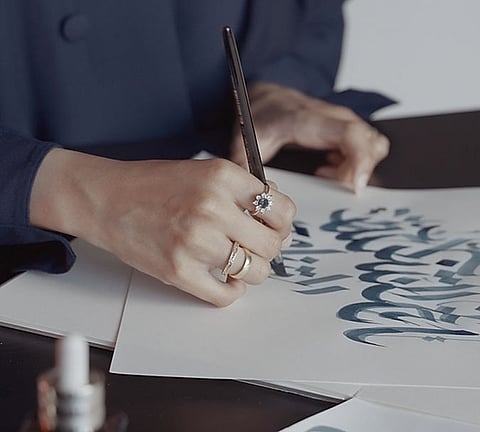Saudi calligrapher brings the spirit of Ramadan and Eid to Harrods
Mawadah Muhtasib works with iconic British luxury emporium to create two bespoke artworks

There’s no more meaningful way to celebrate the holy spirit of Ramadan and Eid than by delving into heritage and drawing inspiration from it. Undoubtedly, Arabic calligraphy is not only an art form with unique aesthetic beauty, but a true reflection of heritage and culture. It holds profound power as one of the most prominent fine arts that defines Arabic and Islamic traditions. To mark Ramadan and Eid this year, Harrods has collaborated with celebrated Saudi visionary Mawadah Muhtasib- a partnership that deepens the appreciation for Arabic artistic expression and evokes a profound connection to language, culture, and spirituality. The Kurator caught up with Muhtasib, renowned for her masterful approach to Arabic calligraphy, to discuss the collaboration and its significance.
How does Arabic calligraphy reflect the spirit of Ramadan?
Arabic Calligraphy has long been used to preserve cultural and spiritual heritage, making it a fitting medium to express the beauty and depth of Ramadan.
Your calligraphy style blends tradition with modernity, particularly through Muthana (mirror writing) and reverse script. Why did you choose this approach, and how does it differ from other Islamic calligraphy styles?
I was drawn to Arabic calligraphy for its balance—precise yet expressive, structured yet full of movement. My reversed calligraphy using the Muthana technique challenges the way we engage with Arabic script, shifting its direction while maintaining its essence. It allows people to see the familiar in a new light, sparking curiosity and engagement. Unlike traditional styles that focus on historical forms, my approach merges heritage with a contemporary rhythm, making calligraphy more accessible and adaptable to modern design.
How do the aesthetics of your calligraphy align with Harrods’ vision for their Ramadan and Eid campaign?
Harrods’ vision for Ramadan and Eid is about celebrating tradition with refinement and elegance - values that align perfectly with my work. My calligraphy, combined with floral motifs, captures both the richness of Arabic heritage and the luxurious, timeless feel that Harrods represents.
You used deep blue for “Ramadan Kareem” and bright pink for “Eid Mubarak.” What inspired these colour choices, and what significance do they hold?
Deep blue carries a sense of serenity, reflection, and depth - qualities that embody the spiritual and contemplative nature of Ramadan. In contrast, bright pink symbolizes joy, festivity, and warmth, reflecting the celebratory spirit of Eid. By pairing calligraphy with meaningful colour choices, I wanted to visually capture the transition from the tranquility of Ramadan to the vibrance of Eid.
Your work combines Arabic calligraphy with floral motifs. How does this fusion of nature and script strengthen the connection between tradition and modern luxury?
I incorporated Islamic floral motifs, drawn from traditional art, architecture, and history, to bring a sense of harmony and spirituality to my calligraphy. These motifs have long been a symbol of beauty in Islamic design, and by integrating them, I aimed to create a refined fusion of heritage and modern luxury. This approach aligns with Harrods’ vision, blending tradition with contemporary elegance.
How does your collaboration with Harrods appeal to a global luxury audience, and what impact do you hope it has?
By bringing Arabic calligraphy into a luxury setting, this collaboration showcases its artistic value beyond traditional contexts. I hope it encourages more brands to embrace Arabic calligraphy as a refined and versatile design element.
Your designs are featured on Harrods’ Eid gift packaging. How does incorporating Arabic calligraphy into luxury gifting elevate the Ramadan and Eid experience?
Luxury gifting is about creating an experience—something meaningful, refined, and memorable. Arabic calligraphy, with its fluidity and depth, adds an artistic and cultural richness to the act of giving. By integrating calligraphy into Harrods’ Eid gift packaging, it transforms the gift into something beyond just an object—it becomes a piece of art, a symbol of tradition, and an expression of celebration.
Harrods has collaborated with Arab calligraphers for three years now. What does this growing appreciation for Arabic calligraphy mean for artists like you? What makes your collaboration unique, and how does it build on the previous ones?
The continued collaboration between Harrods and Arab calligraphers highlights a growing recognition of Arabic calligraphy as a versatile art form. For artists like me, this shift is significant , it opens doors for calligraphy to be seen not just in historical or religious contexts but as a sophisticated design element in global luxury spaces. What makes my collaboration unique is the way I incorporate reversed calligraphy and floral elements, giving a fresh perspective to Arabic script. By blending heritage with contemporary aesthetics, my work builds on previous collaborations while offering something distinctive
Sign up for the Daily Briefing
Get the latest news and updates straight to your inbox


